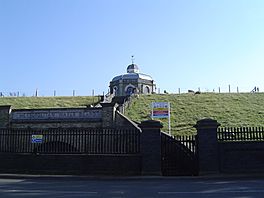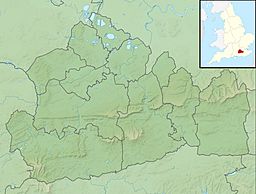Knight Reservoir facts for kids
Quick facts for kids Knight Reservoir |
|
|---|---|

Input station for Knight and Bessborough Reservoirs
|
|
| Location | Surrey |
| Coordinates | 51°23′56.6″N 0°23′36.2″W / 51.399056°N 0.393389°W |
| Type | reservoir |
| Basin countries | United Kingdom |
| Surface area | 50.5 ha (125 acres) |
| Water volume | 5.46 Gl (1.20×109 imp gal) |
The Knight Reservoir is a really big reservoir located in Surrey, England. It was opened in 1907. This reservoir stores a huge amount of raw water. This water is taken from the River Thames. It's held here before it gets cleaned. Then, it's supplied to homes in London and north Surrey. The reservoir is found south of the River Thames. It's also west of West Molesey. It sits between Hurst Road (A3050) and Walton Road (B369). Right next to it, on its west side, is its twin, the Bessborough Reservoir.
Contents
How the Reservoir Was Built
Back in 1898, a company called the Southwark and Vauxhall Waterworks Company needed more space to store water. They had a water plant in Hampton. To get more storage, they asked for legal permission. This permission allowed them to build two large reservoirs. They also planned an intake from the River Thames. Plus, they would build a pump house and filter beds.
This plan was approved by a law in 1898. Work on the reservoirs began that same year. They started building on land where an old house called Apps Court used to be.
Changes in Ownership
The construction was not finished by 1902. In that year, a new group was formed. It was called the Metropolitan Water Board (MWB). This board was created by a new law. The MWB took over many water companies. This included the Southwark and Vauxhall Waterworks Company. So, the MWB took charge of the partly built reservoirs at Walton.
The MWB continued building the reservoirs. They were finally opened in 1907.
Reservoir Details and Features
The Knight and Bessborough reservoirs are next to each other. Together, they cover an area of about 125.5 acres (0.5 square kilometers). They can hold 1,198 million gallons of water.
Here are some key facts about each reservoir:
| Feature | Knight Reservoir | Bessborough Reservoir |
|---|---|---|
| Capacity (how much it holds) | 2,180 Million litres | 3,260 Million litres |
| Surface area (size on top) | 20.8 hectares | 30 hectares |
| Perimeter (distance around) | 1,800 meters | 2,000 meters |
| Total earth dug out | 1.15 million cubic meters | |
| Special clay used | 153,000 cubic meters | |
| Concrete used | 57,000 cubic meters | |
The walls of the reservoirs are very strong. They have a special core made of puddle clay. This clay goes deep down into the ground. It reaches the blue London Clay layer. This helps make the walls waterproof.
The pipes that bring water in are near the north wall. The water discharge tower is also there.
Water Flow and Ownership Changes
Water from these reservoirs used to travel under the river. It would then flow by gravity to the filter beds. These filter beds were at the Hampton Water Works.
The Metropolitan Water Board ran the reservoirs for many years. But in 1974, the board was closed down. A new group took over. This was the Thames Water Authority (TWA). Later, in 1989, the water supply industry became private. The TWA then became Thames Water, which still operates today.
The Knight and Bessborough Reservoirs are also a special place. They are a Site of Special Scientific Interest. This means they are important for nature and wildlife.
How the Reservoirs Work
Water is taken from the River Thames. It flows into an open channel. Then, powerful pumps lift this water into the reservoirs. There were four main pumps. They were first powered by steam engines. Each engine was very strong. They could pump 114 million litres of water every day.
The reservoirs help clean the water in a few ways. First, dirt and tiny bits settle to the bottom. Second, sunlight helps clean the water naturally. Third, the reservoirs act as a huge storage tank. This means there's always enough water, even when the river level is low.
Water Treatment and Improvements
Originally, water from the reservoirs flowed under the river. It went by gravity to the filter beds at Hampton. The reservoirs were about 9.7 meters higher than the filter beds. This height difference helped push the water. The flowing water also powered three hydraulic turbines. These turbines were connected to pumps. They helped lift river water into the reservoirs. Besides Knight and Bessborough, there were four smaller rectangular reservoirs nearby.
In the 1920s, a water treatment plant was built. It was located north of the reservoirs. By 1933, this plant had six large sand filters. These filters helped clean the water even more.
Over time, the equipment was updated. In 1926, the steam engines were changed. They became more efficient. More filter beds were added in 1950.
As more people needed water, more plant and equipment were added. In 1962, the Queen Elizabeth II reservoir was opened. This also helped meet the growing demand. The old steam engines were replaced with electric motors in 1964. This made the pumping system more modern and efficient.


